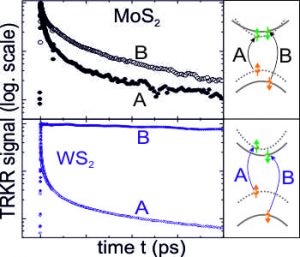Atomically thin transition-metal-dichalcogenides (TMDCs) have recently attracted a lot of research interest. Like graphene, they can be prepared as two-dimensional crystals by exfoliation. Unlike graphene, they are semiconductors with large band gaps, which change from indirect to direct in the monolayer limit. The band extrema of the monolayers are located at the corners of the hexagonal Brillouin zone (K valleys), and both valence- and conduction bands have a large spin splitting, with opposite sign in the K+ and K– valleys, coupling spin and valley degrees of freedom. Optical selection rules allow valley-selective excitation of excitons by circularly polarized light. Excitons in the TMDC monolayers are characterized by very large binding energies due to the weak dielectric screening and strict two-dimensional confinement, making them stable well beyond room temperature. The combination of tightly bound excitons with spin-valley-coupling makes these materials highly interesting for potential optoelectronic device applications.
 While various TMDCs share these properties, there are subtle differences between molybdenum- and tungsten-based materials, namely the magnitude and the ordering of the spin splitting. In molybdenum-based TMDC monolayers, the transition from the upper valence band to the lower conduction band is optically allowed, so that the lowest-energy exciton state is optically bright. By contrast, the conduction-band splitting in tungsten-based TMDCs is opposite, so that the lowest-energy exciton state is optically dark. These differences have been shown to influence exciton recombination dynamics, and are also expected to influence valley dynamics.
While various TMDCs share these properties, there are subtle differences between molybdenum- and tungsten-based materials, namely the magnitude and the ordering of the spin splitting. In molybdenum-based TMDC monolayers, the transition from the upper valence band to the lower conduction band is optically allowed, so that the lowest-energy exciton state is optically bright. By contrast, the conduction-band splitting in tungsten-based TMDCs is opposite, so that the lowest-energy exciton state is optically dark. These differences have been shown to influence exciton recombination dynamics, and are also expected to influence valley dynamics.
Scientists from Münster and Regensburg have studied the valley dynamics of excitons in different TMDCs using time-resolved Kerr rotation (TRKR) at low temperatures. They find pronounced differences between the tungsten-based TMDCs and MoS2: in the two tungsten-based materials, there is a very rapid initial decay of valley polarization due to exciton recombination on picosecond timescales. However, there are additional intra- and intervalley energy relaxation processes leading to the formation of optically dark excitons, which still carry a valley polarization. This subset of dark excitons decays on much longer timescales, and its decay is mediated by exciton-exciton annihilation, leading to a characteristic long tail in the TRKR traces. Such a feature is absent in the valley dynamics of MoS2. When exciting transitions from the lower valence band to the conduction band (B excitons), they observe a rapid decay of valley polarization in MoS2, due to relaxation channels within conduction and valence bands. By contrast, exciting the same transition in WS2 yields very long-lived valley polarization.
These results highlight the significant impact of subtle differences between specific TMDCs on valley dynamics and potential valleytronics applications.
Text kindly provided by Dr. Tobias Kon.

















